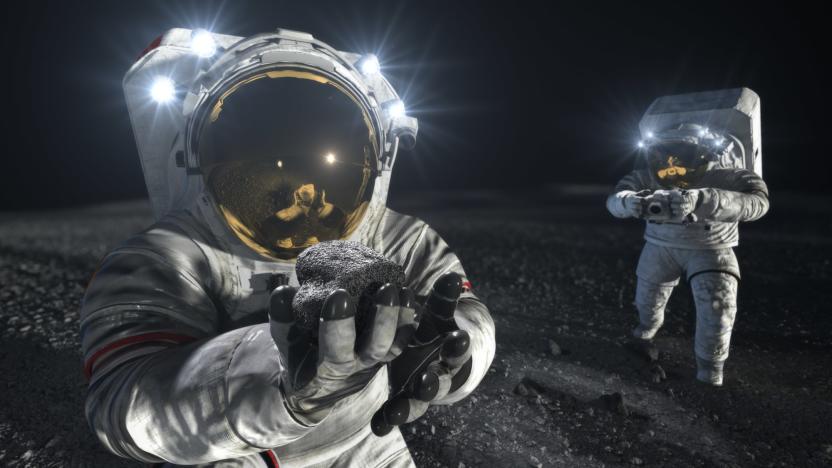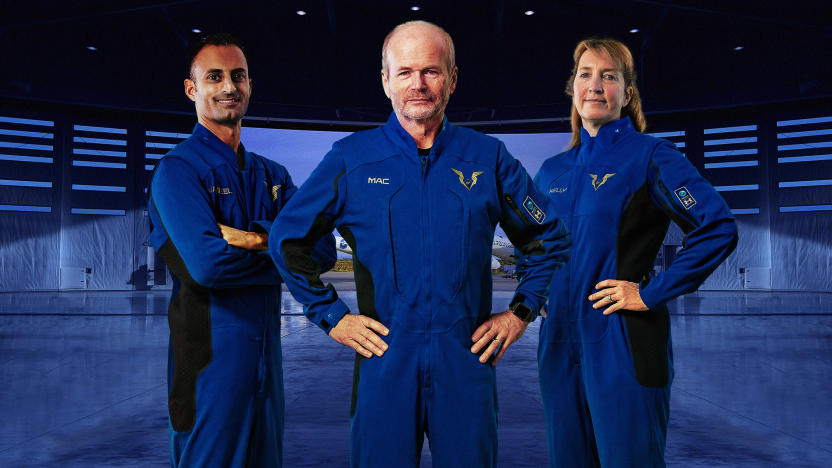spacesuits
Latest

NASA chooses two companies to develop next-gen spacesuits
NASA has announced that Axiom Space and Collins Aerospace will build its next-generation spacesuits.

Virgin Galactic reveals its new Under Armour pilot spacesuits
Virgin Galactic has revealed the spacesuits that its test pilots will wear on the first rocket-powered test flight from its new Spaceport America facility in New Mexico.

ICYMI: Crowdsourcing the space poop problem
try{document.getElementById("aol-cms-player-1").style.display="none";}catch(e){} Today on In Case You Missed It: NASA and HeroX are asking for help from the public to try to create a bathroom that can be used for up to six days, inside space suits. Previously astronauts have worn diapers during missions in space suits, but that's only a short-term solution that won't work for the US goal to get to Mars. You can read more about the request here.

Recon Instruments gets NASA Desert RATS eyes-on with Micro Optics Display, lets them see the future
Outer space. The words alone conjure images of high-tech gadgetry and mind-blowing scientific research -- that is to say, the future. But what if we told you our best and brightest cosmic explorers were still relying on arm-mounted post-it notes to guide them through spacewalks? Yes, that would be Staples in space. Luckily, Recon Instruments has partnered with NASA Desert Research and Technology Studies to test two variants of its GPS-enabled Micro Optics Display for use in next-generation spacesuits, and get our space agency a wee bit closer to the P.K. Dick fantasy we hold dear. The customized goggles, which deliver information direct-to-eye, were put to task by the Arizona desert-based team, undergoing a series of simulated critical mission procedures. The end result? A resounding thumbs-up approval from NASA (not to mention deceased sci-fi authors), and a promise to evaluate the tech for further testing. Do you hear that sound, rocketeers? Silly us. Of course, you can't -- in space, no one can hear our applause.

SGW images depict spacesuits, Egyptian mythology
Outer space and Egyptology; it was out of the marriage of these two things that the original Stargate movie was born. While the popular TV series Stargate SG-1 and even more so its spinoff Stargate Atlantis have moved away from Ancient Egypt over the years to explore other mythologies or Star Trek-style science-driven-concepts like self-replicating nanobots gone mad, rest assured that the Egyptian motif is still intact in Cheyenne Mountain's MMO Stargate Worlds.The evidence: the above, decidedly-Egyptian screenshot, which is one of four new images just released to the game's official gallery. Note the awesome-looking disintegrating moon in the sky. Sweet! To cover the outer space side of things, one of the other images depicts artist's conceptions of humans' spacesuits. The other two images: concept art of a war-torn, bunker-type area, and yet another screenshot of forest ruins.

Motion-sensitive "power skins" could generate power in space
Just in case you ever plan on heading up into space to see your soon-to-be-painted logo on the Y*N*I*S satellite up close and personal, you might be interested in this. Devised by researchers at a Cambridge-based venture, dubbed IntAct Labs, the motion-sensitive "power skin" could be used and worn by humans and inanimate objects alike in order to generate electricity, and the concept was derived from our very ears. After investigating how biological organisms are such "ultra-efficient generators of power," the crew homed in on a tiny protein called prestin, which can "convert electrical voltage into motion or produce electrical charges in response to mechanical stresses," and is actually found in the outer hair cells of the human ear. Ideally, networks of these proteins would be linked in order to form skins that could coat people or objects and generate energy from something as simple as walking around or being in the path of wind gusts, and if everything pans out, a prestin-powered research station could be set up on Mars without a manmade perpetual power source in tow.[Thanks, Sparky]




